Regional Anaesthesia
QUESTIONS
Before continuing, try to answer the following questions. The answers can be found at the end of the article, together with an explanation. Please answer True or False:
- The following are indications for Pecs I or II block:
a. Breast expander surgery
b. Portacath implantation
c. Sentinel node biopsy
d. Breast reconstruction
e. Latissimus dorsi flap reconstruction - The following is the target in Pecs II block:
a. Between pectoralis major and minor muscles
b. Between pectoralis minor and the serratus anterior muscles
c. Between serratus anterior and latissimus dorsi muscles
d. Below teres major muscle
e. Above transverses abdominus - The following statement is true:
a. Pecs block can be performed as rescue analgesia.
b. Catheter insertions are possible for continuous infusion analgesia.
c. Bilateral blocks cannot be performed.
d. Pecs II is performed at the level of the 5th-6th ribs
e. Ultrasound is not needed to perform Pecs blocks.
Key Points
- Pecs blocks are thoracic regional fascial plane blocks useful for breast surgery and procedures involving the chest wall
- Pecs I block – a single injection between pectoralis major and pectoralis minor muscles which blocks the lateral and medial pectoral nerves
- Pecs II block – Pecs I block and an additional injection between pectoralis minor and serratus anterior which blocks the intercostal and intercostobrachial nerves
- More extensive procedures may require blockade of the supraclavicular nerves or a serratus plane block.
- Ultrasound guidance is required for the block
INTRODUCTION
The Pecs I and Pecs II blocks are superficial thoracic wall blocks which through blockade of the pectoral and intercostal nerves can be used to provide analgesia for breast surgery and other procedures / surgery involving the anterior chest wall.
Using ultrasound guidance local anaesthetic is placed between the muscles of the thoracic wall. They are simple to perform, reduce postoperative analgesic requirements and avoid the use of more invasive techniques such as paravertebral blockade.
Bilateral blocks and catheter insertions for continuous infusion can also be used for both Pecs blocks. It should be noted that blockade of the long thoracic and thoracodorsal nerves usually requires a serratus anterior plane block. [Serratus anterior plane block will be discussed in a separate tutorial]
ANATOMY
The innervation of the breast is supplied mainly by the anterior branches of the 4th, 5th and 6th intercostal nerves which arise from the thoracic spinal nerves (T4-6).
The apex of the axilla is supplied by the intercostobrachialis nerve; this is a cutaneous branch of the second intercostal nerve (T2). The pectoral major and minor muscles are innervated by the lateral pectoral nerve (C5-7) and medial pectoral nerve (C8-T1).
The long thoracic nerve (C5-7) supplies the serratus anterior muscle.
The thoracodorsal nerve (C6-8) supplies latissimus dorsi and this is relevant for more extensive procedures.
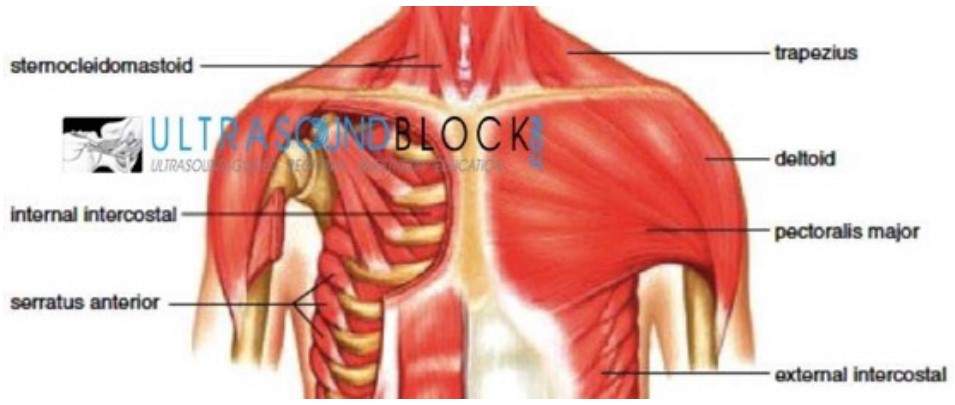
Figure 1. Anterior thoracic wall muscles. (Image supplied by Dr. M Fredrickson at ultrasound block.com)
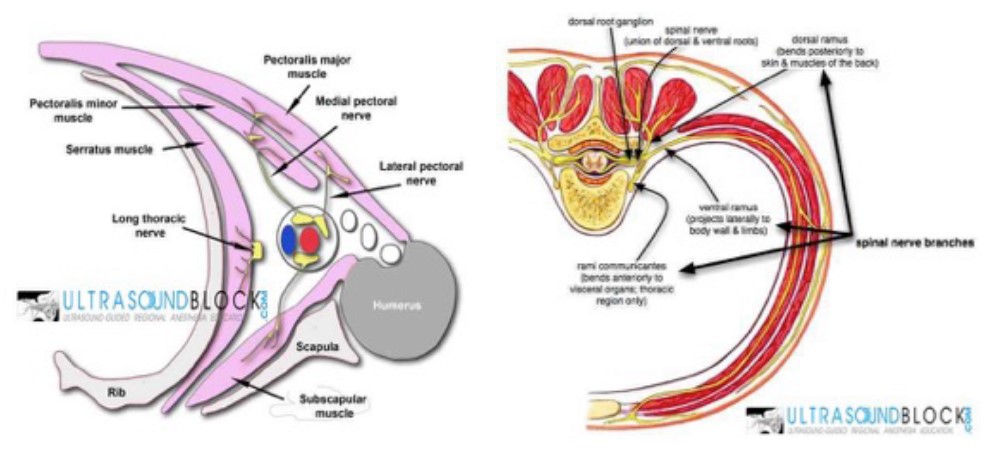
Figure 2. Left: Innervation of the thoracic wall muscles at the axillary level; Right: Branches of the spinal innervating the chest wall. (Image supplied by Dr. M Fredrickson at ultrasound block.com)
Terminal branches of the supraclavicular nerves (C3-4) innervate the upper part of the breast and this should be taken into account when the surgical procedure involves this area (e.g. Portacaths and Hickman lines) because Pecs blocks will not block the supraclavicular nerve. Breast surgery however, is rarely performed at this level.
PECS I BLOCK
The Pecs I block is a single injection of local anaesthetic between pectoralis major and pectoralis minor muscles at the level of the 3rd rib to anaesthetise the lateral and medial pectoral nerves (LPN and MPN).
Indications
Surgery limited to pectoralis major e.g. unilateral surgery such as insertion of breast expanders and submuscular prostheses, portacaths and implantable cardiac defibrillators/pacemakers, anterior thoracotomies and shoulder surgery involving the deltopectoral groove.
Technique

Probe position and sonography for Pecs I
- Place the probe inferior to the clavicle (Figure 3)
- Identify the pectoralis muscles with the axillary artery and axillary vein on sonography. The brachial plexus should be visible underneath. (Pectoralis major is the most superficial, pectoralis minor lies underneath (Fig 4).
- Look for a vascular branch moving between the pectoral muscles from medial to lateral. This is the lateral pectoral branch of the thoraco-acromial artery.
- The author prefers to rotate the probe so that it is oblique to the spine and medial to the coracoid process. In this way, it will also be in a position suitable for Pecs II block (Fig 5). This is the original description for this block.
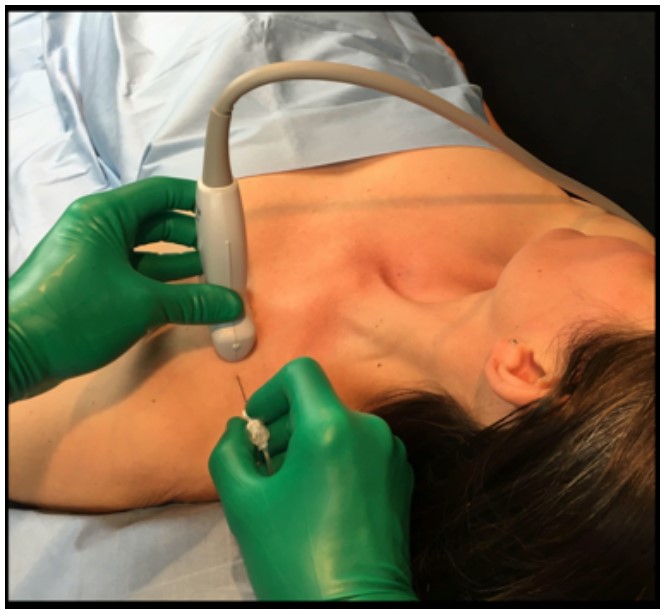
Figure 3: Pecs I block- probe and needle placement
The needle can be introduced in-plane cephalic to inferior (Fig 3) or if you have rotated your probe it will be a medial to lateral approach. Use hydrolocation with saline or local anaesthetic to identify and open the space between the pectoralis muscles. It may be preferable to use saline for hydrolocation so as to not waste any local anaesthetic.
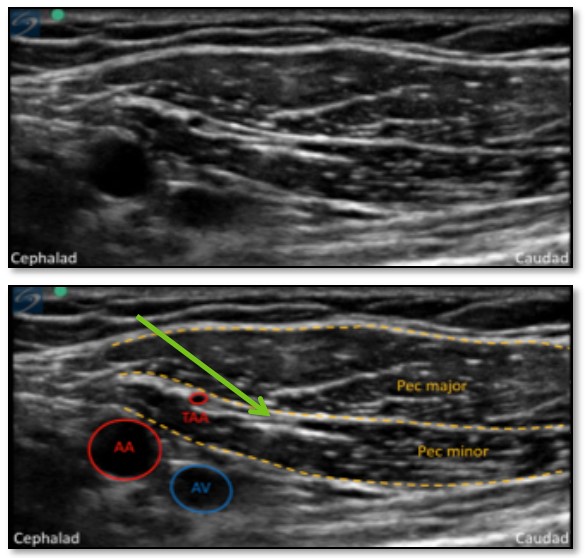
Figure 4. Sonoanatomy Pecs I. Needle will be seen to approach from cephalad end. Local anaesthesia will injected in the space between the Pec major and Pec minor. AA: axillary artery, AV: axillary vein, TAA: thoraco-acromial artery Image supplied by Dr. Kim Chishti, Consultant Anaesthetist, Derriford Hospital, UK
PECS II BLOCK
The Pecs II block is a modified Pecs I block and can be achieved with one needle insertion point. Local anaesthetic is placed between pectorals major and minor as for a Pecs I block and then between pectoralis minor and serratus anterior muscles. This results in local anaesthetic spread under the ligament of Gerdy. The ligament of Gerdy is a thick fascia that gives the concave shape to the axilla. On its medial side it attaches to the lateral side of the pectoral muscle. This second injection will anaesthetise the anteriocutaneous branches of the intercostal nerves, the intercostobrachialis and the long thoracic nerves.
Indications
Similar to Pecs I with some additions: tumour resections, mastectomies, sentinel node biopsies and axillary clearances.
Technique

Probe position and sonography for Pecs II
- Start as for Pecs I with the probe at the mid clavicular level and angled inferolaterally (Fig 5)
- Identify pectoralis minor and serratus anterior on sonography. This may require moving the probe laterally from your Pecs I probe position.
- Locate the 2nd rib immediately under the axillary artery then count the 3rd rib.
- Move the probe laterally to identify the 4th rib (Fig 6).
- At this position, 10mls of local anaesthetic can be deposited between pectoralis major and minor (Pecs I) then the needle advanced to deposit 15-20mls of local anaesthetic between pectoralis minor and serratus anterior (Pecs II)
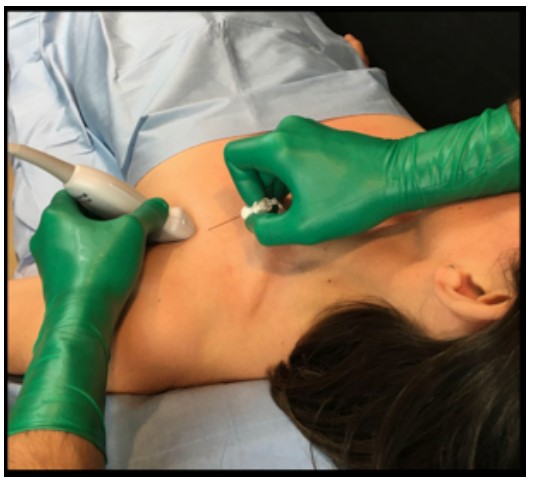
Figure 5. Pecs II block- probe and needle placement
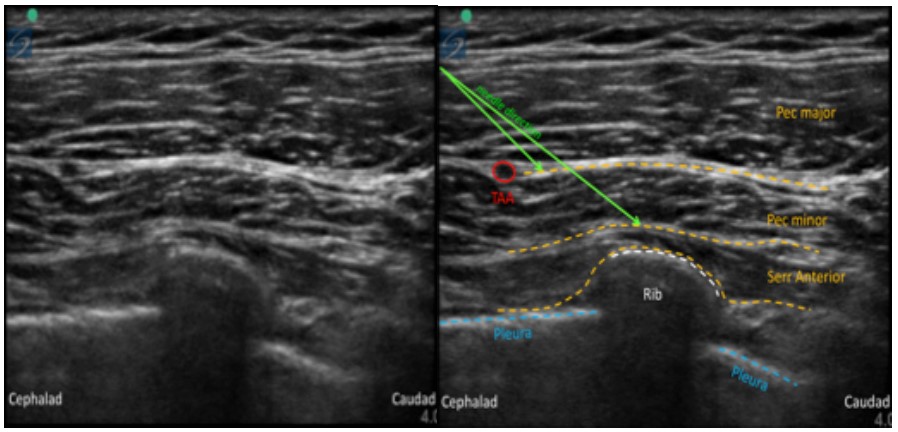
Figure 6. Sonoanatomy Pecs II. Needle will be seen to approach from the cephalad end. Local anaesthesia will be injected at two points. One in the space between pectoralis major and minor and the other in the compartment between pectoralis minor and serratus anterior. AA: axillary artery, AV: axillary vein, TAA: thoraco-acromial artery Image supplied by Dr. Kim Chrishti, Consultant Anaesthetist, Derriford Hospital, UK
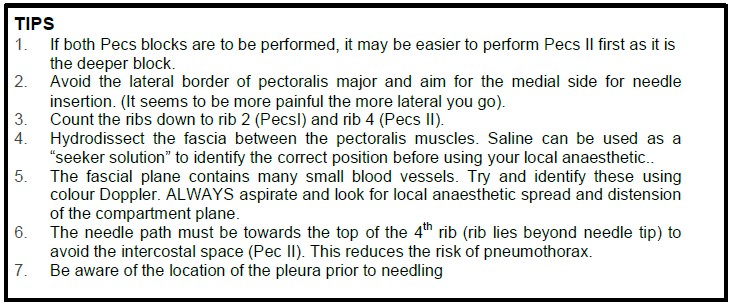
SUMMARY
Pecs blocks are a useful addition to analgesia for chest wall surgery, potentially avoiding more invasive procedures such as paravertebral blockade. Serratus plane or supraclavicular nerve blocks may also be needed for complete analgesia. An ultrasound machine is necessary for the performance of this regional nerve block.
ANSWERS TO QUESTIONS
- The following are indications for Pecs I or II block:
a. True
b. True
c. True
d. True
e. False: This would require a serratus plane block - The following is the target in Pecs II block:
a. True: In Pecs II the first injection is between pectoralis major and minor
b. True: In Pecs II the second injection is between pectoralis minor and the serratus anterior muscle towards the 4th rib.
c. False: This is the serratus plane block
d. False: In the scanning to perform the serratus plane block we could see the teres major muscle, but it is not our target in Pecs II.
e. False: This is the transversus abdominis plane (TAP) block for the abdomen. - The following statement is true:
a. True
b. True: The placement of catheters are possible and useful, providing continuous analgesia; the insertion is between pectoralis major and minor muscles.
c. False: Bilateral blocks can be performed. The maximum safe dose of local anaesthetic needs to be calculated.
d. False: Pecs II is performed at the level of the 4th rib.
e. False: Ultrasound is needed to perform Pecs blocks.
ACKNOWLEGEMENT
We would like to thank Dr. Kim Chishti for reviewing the article and for contributing the photographs and ultrasound images and Dr. M Fredrickson for the permission to use the images from ultrasound block.com.
REFERENCES and FURTHER READING
- Blanco R. The ‘pecs block’: a novel technique for providing analgesia after breast surgery. Anaesthesia 2011; 66 (9): 847-848.
- Blanco R, Fajardo M, Parras T. Ultrasound description of Pecs II (modified Pecs I). A novel approach to breast surgery. Rev Esp Anestesiol Reanim 2012; 59 (9): 470-475. http://www.csen.com/pecs.pdf
- U-tube video; Dr Amit Pawa, LSORA PECS II Block https://www.youtube.com/watch?v=YFWneF4pwOA (accessed 11.10.16)



